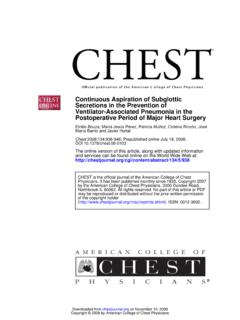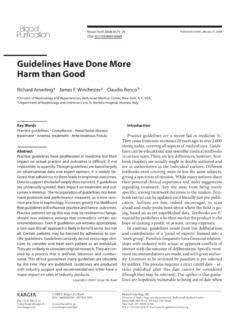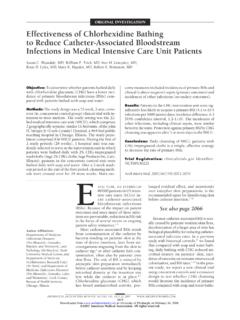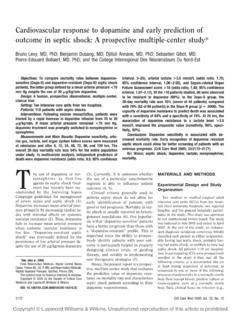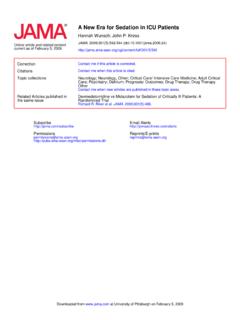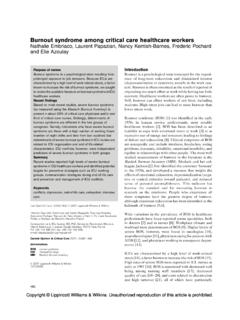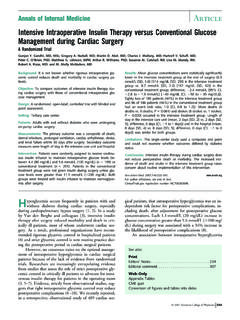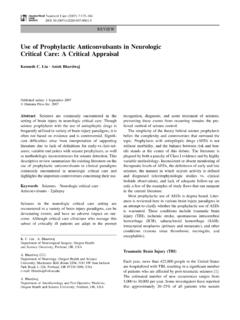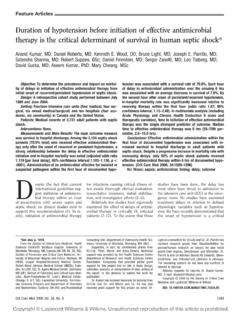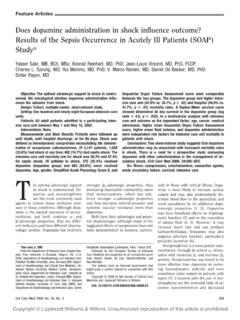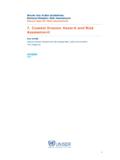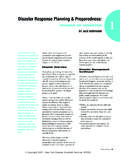Transcription of Year in review in Intensive Care Medicine, 2006. II ...
1 Intensive care MedDOI IN review 2006 Peter AndrewsElie AzoulayMassimo AntonelliLaurent BrochardChristian Brun-BuissonDaniel De BackerGeoffrey DobbJean-Yves FagonHerwig GerlachJohan GroeneveldDuncan MacraeJordi ManceboPhilipp MetnitzStefano NavaJer me PuginMichael PinskyPeter RadermacherChristian RichardYear in review in Intensive care Medicine, 2006. II. Infections and sepsis,haemodynamics, elderly, invasive andnoninvasive mechanical ventilation, weaning,ARDSR eceived: 18 December 2006 Accepted: 18 December 2006 Springer-Verlag 2007 This review summarizes all articlespublished in Intensive care Medicine in2006, grouped by specific AndrewsWestern General Hospital, Intensive CareMedicine Unit,Edinburgh, UKE. AzoulaySaint Louis Hospital, Intensive CareMedicine Unit,Paris, FranceM.
2 AntonelliUniversita Cattolica del Sacre Cuore,Department of Intensive care andAnesthesiology,Rome, ItalyL. Brochard ( )Universit Paris 12, INSERM U 651,R animation M dicale, AP-HP, H pitalHenri Mondor,Cr teil, Francee-mail: +33-1-49812545 Fax: +33-1-42079943C. Brun-BuissonUniversit Paris 12, R animation M dicale,AP-HP, H pital Henri Mondor,Cr teil, FranceD. De BackerErasme Hospital, Service des SoinsIntensifs,Brussels, BelgiumG. DobbRoyal Perth Hospital, Intensive CareMedicine Unit,Perth, FagonEuropean Georges Pompidou Hospital, Intensive care Medicine Unit,Paris, FranceH. GerlachVivantes-Klinikum Neukoelln, Departmentof Anesthesiology,Berlin, GermanyJ. GroeneveldVUMC, Intensive care Medicine Unit,Amsterdam, The NetherlandsD. MacraeRoyal Brompton Hospital, PediatricIntensive care Unit,London, UKJ.
3 ManceboHospital Sant Pau, Intensive care MedicineUnit,Barcelona, SpainP. MetnitzUniversity Hospital of Vienna, Departmentof Anesthesia and General Intensive CareMedicine,Vienna, AustriaS. NavaFondazione S. Maugeri, Intensive CareMedicine Unit,Pavia, ItalyJ. PuginUniversity Hospital of Geneva, IntensiveCare Medicine Unit,Geneva, SwitzerlandM. PinskyUniversity of Pittsburgh Medical Center, Intensive care Medicine Unit,Pittsburgh USAP. RadermacherUniversity Medical School of Ulm,Department of Anesthesia,Ulm, GermanyC. RichardUniversity Hospital of Le Kremlin-Bicetre, Intensive care Unit,Le Kremlin-Bicetre, FranceRespiratory infectionsAcute exacerbations of chronic obstructivepulmonary diseaseCameron et al. [1] investigated the possible role of virusesin 107 episodes of acute exacerbations of chronic obstruc-tive pulmonary disease (AECOPD).
4 They used moderndiagnostic tests, including immunofluorescence assay andpolymerase chain reaction, on nasopharyngeal identified infections in 64% of cases, with virusesas probable responsible pathogens in 43%: influenza typeA (13%) and rhinovirus (8%) were the most commonorganisms. Bacteria were found in 23% of cases, withHaemophilus influenzaeas the most common pathogen(11%). The authors failed to find significant differencesin clinical characteristics and outcome between virus-infected and noninfected patients. In his related editorial,Luyt [2] comments more generally on virus in intensivecare unit (ICU) patients, emphasizing (1) the questionablerelationship between viral diseases and outcome, (2) thedoubtful reliability ofmodern diagnostic tests with a riskof false-positive results and (3) as a consequence, therelevance of viral detection in respiratory tract secretions:detection of a virus does not mean effusions and empyemasBased on the use of chest radiography and/or ultrasound,Tu et al.
5 [3] studied 175 febrile medical ICU patients withpleural effusion. After thoracentesis, they found that 45%of these patients complicated parapneumonic effusions orempyemas. The presumptive causes of such complicatedinfected pleural effusions were hospital-acquired pneu-monia (47%), community-acquired pneumonia (46%) orprimary empyema (5%). Cultures were positive in 75%of cases and isolated anaerobes or Candida species werefound in less than 10% of cases. Among the 55 patientswith positive cultures and nontuberculous effusions, 20received initial inadequateantibiotic treatment, witha mortality rate of 75% vs 46% in the 35 patients whosetreatment had been adequate. These data confirm thatcomplicated parapneumonic effusions and empyemasare severe disease in medical ICU patients, and thatinadequate initial antimicrobial therapy is an importantprognostic acute respiratory syndromeIn a retrospective study conducted in one ICU in HongKong, receiving only patients with confirmed or suspectedsevere acute respiratory syndrome (SARS), Gomersall etal.
6 [4] described the transmission of SARS to healthcareworkers (35 doctors and 152 nurses). During the study pe-riod, 67 patients were admitted to the ICU with a medianlength of ICU stay of 13 days. With rigorously appliedinfection control procedures, only five ICU staff members(four nurses and one healthcare assistant) developedSARS, despite long staff exposure times (284 h for doctorsand 119 h for nurses) and a substandard physical andarchitectural environment. Three of the five cases occurredearly in the outbreak (within 10 days of admission of thefirst patient with SARS), suggesting that infection controlprocedures must be applied rigorously from the start of anepidemic. Thus, the risk for healthcare workers to acquireSARS is pneumoniaA rapid immunochromatographic membrane test (ICT),the newStreptococcus pneumoniaeurinary antigen assay,was studied in a population of 140 ICU patients: 32without community-acquired pneumonia (CAP), 32 withpneumococcal CAP and 76 with nonpneumococcal ICT was positive in 23/34 patients with pneumococcalCAP, 11 of 76 patients with nonpneumococcal CAP andnone of 32 patients without CAP.
7 Sensitivity, specificity,and positive and negative predictive values were 72%,90%, 68% and 92%, respectively. Among patients whohad received prior antibiotic therapy, the operating charac-teristics of ICT were not modified. These results reportedby Lasocki et al. [5], comparable with those observed inoutpatients and non-ICU inpatients, do not permit definiteconclusions regarding the clinical interest and impact ofsuch diagnostic techniques on the management of patientswith severe maxillary sinusitisMaxillary sinusitis is a frequent complication occur-ring in intubated patients, often underestimated andunder-diagnosed. The systematic search and treatmentof nosocomial maxillary sinusitis (NMS) have been dis-cussed to prevent the occurrence of prospective, open-label randomized study conducted in79 multiple trauma patients expected to be mechanicallyventilated for more than 3 days was designed to investigatethe efficacy of locally applied nasal decongestant agent(xylometazoline, ) and corticosteroids (100 g budes-onide) for preventing NMS.
8 Compared with the placebogroup, patients receiving topical treatment less frequentlydeveloped radiological maxillary sinusitis (54% vs 82%;p< ); in contrast, the incidences of infectious maxil-lary sinusitis (8% vs 20%;p= ), and of VAP (15% vs27%; NS) were not significantly different. This first clin-ical evaluation suggests that the use of pharmacologicalagents to reduce inflammation may have a beneficial ef-fect in preventing maxillary sinusitis; however, from thedata reported by Pneumatikos et al. [6], it is difficult torecommend this practice as a routine prevention strategyin mechanically ventilated diagnosis of NMS in ICU patients treated withmechanical ventilation (MV) is usually based on com-puterized tomography (CT) and isolation of organismsfrom material obtained after transnasal puncture.
9 To avoidthe transportation of patients outside the ICU, transnasalpuncture based on sinus echography merits valuation. Tothis end, Vargas et al. [7] conducted a prospective study in60 patients with a clinical suspicion of maxillary sinusitis(120 sinuses were examined). The definition of positiveechography was the visualization of the hyperechogenicposterior wall of the sinus associated or not with extensionto the internal and external walls of the sinus. Whensinus ultrasound was positive, a transnasal puncturewas performed and considered as positive if fluid wasobtained from sinus aspiration. The study was designedto evaluate the value of echography to obtain positivetransnasal puncture. Sinus ultrasound was positive in84 cases, and 78 of these 84 transnasal punctures werepositive.
10 On the other hand, when sinus ultrasound wasnegative, no sinusitis was observed on CT. This studysuggests that transnasal puncture could be performeddirectly on the results of a sinus echography. However, asother echographic examination, sinus ultrasound can beoperator-dependent. Thus, before generalization, precisedescription and standardization of this procedure in thespecific population of mechanically ventilated patientsmust be pneumoniaThere is considerable evidence to suggest that specificinterventions can be effectively employed to preventventilator-associated pneumonia (VAP). Measures toprevent VAP extend into all aspects of daily intensivecare practice, including oral care and the suction ofrespiratory secretions. Mori et al. [8] studied whetheroral care contributes to preventing VAP by comparing1,252 patients who received oral care with 414 historicalcontrols.
